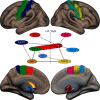Chronic Musculoskeletal Pain Moderates the Association between Sleep Quality and Dorsostriatal-Sensorimotor Resting State Functional Connectivity in Community-Dwelling Older Adults
- PMID: 35432664
- PMCID: PMC9010216
- DOI: 10.1155/2022/4347759
Chronic Musculoskeletal Pain Moderates the Association between Sleep Quality and Dorsostriatal-Sensorimotor Resting State Functional Connectivity in Community-Dwelling Older Adults
Abstract
Aging is associated with poor sleep quality and greater chronic pain prevalence, with age-related changes in brain function as potential underlying mechanisms. Objective. The following cross-sectional study aimed to determine whether self-reported chronic musculoskeletal pain in community-dwelling older adults moderates the association between sleep quality and resting state functional brain connectivity (rsFC). Methods. Community-dwelling older individuals (mean age = 73.29 years) part of the NEPAL study who completed the Pittsburg Sleep Quality Index (PSQI) and a rsFC scan were included (n = 48) in the present investigation. To that end, we tested the effect of chronic pain-by-PSQI interaction on rsFC among atlas-based brain regions-of-interest, controlling for age and sex. Results and Discussion. A significant network connecting the bilateral putamen and left caudate with bilateral precentral gyrus, postcentral gyrus, and juxtapositional lobule cortex, survived global multiple comparisons (FDR; q < 0.05) and threshold-free network-based-statistics. Greater PSQI scores were significantly associated with greater dorsostriatal-sensorimotor rsFC in the no-pain group, suggesting that a state of somatomotor hyperarousal may be associated with poorer sleep quality in this group. However, in the pain group, greater PSQI scores were associated with less dorsostriatal-sensorimotor rsFC, possibly due to a shift of striatal functions toward regulation sensorimotor aspects of the pain experience, and/or aberrant cortico-striatal loops in the presence of chronic pain. This preliminary investigation advances knowledge about the neurobiology underlying the associations between chronic pain and sleep in community-dwelling older adults that may contribute to the development of effective therapies to decrease disability in geriatric populations.
Copyright © 2022 Soamy Montesino-Goicolea et al.
Conflict of interest statement
The authors declare no financial or nonfinancial conflicts of interest.
Figures


References
-
- Smith M. T., Haythornthwaite J. A. How do sleep disturbance and chronic pain inter-relate? insights from the longitudinal and cognitive-behavioral clinical trials literature. Sleep Medicine Reviews . 2004;8 - PubMed
-
- OʼBrien E. M., Waxenberg L. B., Atchison J. W., et al. Intraindividual variability in daily sleep and pain ratings among chronic pain patients: bidirectional association and the role of negative mood. The Clinical Journal of Pain . 2011;27(5):425–433. - PubMed
Publication types
MeSH terms
Grants and funding
LinkOut - more resources
Full Text Sources
Medical

